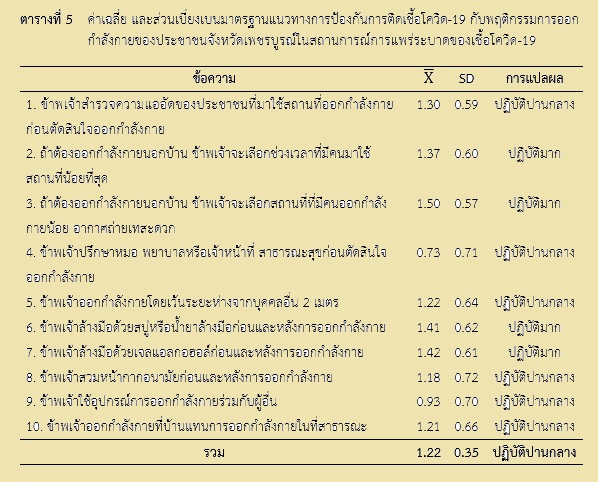THE MOTIVATION FOR EXERCISE OF PEOPLE IN PHETCHABUN PROVINCE WITH COVID-19 EPIDEMIC
Main Article Content
Abstract
Purpose: For studying the motivation of the people in Phetchabun during the spread of Covid-19
Method: This research uses a purposive sampling of 400 people who exercised during the spread of Covid-19. The instrument used in this investigation has passed the examination for the content validity from five qualified experts. The value for content validity is 0.60-1.00 and the precision value is 0.90. The experiment was analyzed using the methods of frequency distribution, percentage, average, standard deviation, t-test, and one-way ANOVA.
Results: (1) In general People in Phetchabun province with COVID-19 epidemic have a high motivation for exercise (mean=3.71), the intrinsic motive is extremely high (mean=4.28) and the extrinsic motive is moderate (mean=3.14). (2) People in Phetchabun's intrinsic and extrinsic motivation are statistically relevant to exercise 0.05. (3) and when comparing males and females, intrinsic and extrinsic motivation are statistically different 0.05, with males creating greater intrinsic and extrinsic motivation than females. (4) The criteria for preventing the COVID-19 epidemic in Phetchabun by exercise is moderate (mean=1.22, SD=0.35).
Conclusion: The criteria for preventing the epidemic with COVID-19 of people in Phetchabun by exercise is moderate, but the motivation for exercise was high. The motivation for exercise of people in Phetchabun with COVID-19 epidemic has impacted the choice to choose the suitable exercise. Thus, the government and private sectors should develop policies and plans for areas that meet the needs of the people, such as facilitating motivation by applying an application for timing, booking, and making safety for people exercising in Phetchabun.
Article Details

This work is licensed under a Creative Commons Attribution-NonCommercial-NoDerivatives 4.0 International License.
References
Bangkok Biz News. (2020). COVID-19 has been declared a global pandemic by the World Health Organization (WHO). (Online). Retrieved March 12, 2020, from Bangkok Biz News Website: https://www.bangkokbiznews.com
Chaleysup, S. (2020). Concerns among Thais about the spread of COVID-19. (Online). Retrieved May 5, 2020, from Siamrath Website: https://siamrath.co.th/n/147514
Chularut, P. (2021). Cognitive Psychology (p. 317). Bangkok: Chulalongkorn University Press.
Department of Disease Control. (2022). Epidemic Reports Coronavirus 2019 . (Online). Retrieved March 20, 2021, from Department of Disease Control Website: https://ddc.moph.go.th/viralpneumonia/file/situation/situation-no73-160363_1.pdf
Hinkle, D.E, William, W. and Stephen G. J. (1998). Applied Statistics for the Behavior Sciences. 4th ed. New York: Houghton Mifflin.
imsiam, T. (2021). Exercise in the midst of the spread of Covid-19. (Online). Retrieved April 2, 2022, from Daily News (Mid – Day) Website: https://www.chula.ac.th/clipping/41144/
Kawjaratwilai, T., Tanphanich, T., Vongsrangsap, S., Makajae, N., Tanphanich, N., Phunsawat, P., Kusolwong, P., and Chai-on, T. (2021). The Guidelines on Exercise Activities in the Spread Period of Coronavirus Disease 2019 (COVID-19). Journal of Health Physical Education and Recreation. 47(1), 18.
Inthuyos, N. (2013). Gerneral Psychology (p. 55). Bangkok: Chulalongkorn University Press.
Issaragrisil, P. (2022). Staying fit to fight of COVIC – 19 Disease. (Online). Retrieved April 2, 2022, from Bangkok Hospital Website: https://www.bangkokhospital.com/en/content/fit-fight-covid-19
Ministry of Public Heath. (2020). epidemic reports coronavirus 2019. (Online). Retrieved November April 29, 2020, from Ministry of Public Heath Website: https://shorturl.asia/qyU4h
Phetchabun Provincial Statistical Office. (2018). Phetchabun Provincial Statistical Report: 2018. Phetchabun: Phetchabun Provincial Statistical Office.
Thai Health Promotion Foundation. Exercise in the New Normal. (Online). Retrieved November 13, 2021, from Thai Health Promotion Foundation Website: https://shorturl.asia/NODnZ
Thibordee, S., and Prasartwuth, O. (2014). Effectiveness of roundhouse kick in elite Taekwondo athletes. Journal of electromyography and kinesiology, 24(3), 353-358.
World Taekwondo. (2018). WT Competition Rules &Interpretation. (Online). Retrieved June 18,2018, from worldtaekwondo.org Website: http://www.worldtaekwondo.org/wp-content/uploads/2018/06/Revision-WT-Competition-Rules-Interpretation-Hammamet-040520181.pdf
Yamane, T. (1973). Statistics: An Introductory Analysis. 3rd ed. Tokyo: Harper International Education. Tokyo.
Yu-Hsiang, N., Jung-San, C., and Wen-Tzu, T. (2007). The Comparison of Kinematics Characteristics of Two Roundhouse Kicking Techniques in Elite Taekwondo Athletes. Medicine & Science in Sports & Exercise, p S478


